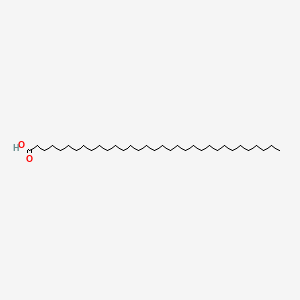| MeSH term | MeSH ID | Detail |
|---|---|---|
| Diabetes Mellitus, Type 2 | D003924 | 87 associated lipids |
| Hypercholesterolemia | D006937 | 91 associated lipids |
| Body Weight | D001835 | 333 associated lipids |
tritriacontanoic acid
tritriacontanoic acid is a lipid of Fatty Acyls (FA) class. Tritriacontanoic acid is associated with abnormalities such as hypercholesterolemia, Metabolic syndrome, Diabetes Mellitus, Non-Insulin-Dependent, Diabetes Mellitus, Insulin-Dependent and Parkinson Disease. The involved functions are known as Fermentation, Process, Longterm Effects, Pressure- physical agent and Lipid Metabolism. Tritriacontanoic acid often locates in Blood, Tissue fiber and A Fibers. The associated genes with tritriacontanoic acid are STN gene. The related lipids are Total cholesterol and blood lipid.
Cross Reference
Introduction
To understand associated biological information of tritriacontanoic acid, we collected biological information of abnormalities, associated pathways, cellular/molecular locations, biological functions, related genes/proteins, lipids and common seen animal/experimental models with organized paragraphs from literatures.
What diseases are associated with tritriacontanoic acid?
tritriacontanoic acid is suspected in hypercholesterolemia, Metabolic syndrome, Diabetes Mellitus, Non-Insulin-Dependent, Diabetes Mellitus, Insulin-Dependent, Parkinson Disease and other diseases in descending order of the highest number of associated sentences.
Related references are mostly published in these journals:
| Disease | Cross reference | Weighted score | Related literature |
|---|
Possible diseases from mapped MeSH terms on references
We collected disease MeSH terms mapped to the references associated with tritriacontanoic acid
PubChem Associated disorders and diseases
What pathways are associated with tritriacontanoic acid
There are no associated biomedical information in the current reference collection.
PubChem Biomolecular Interactions and Pathways
Link to PubChem Biomolecular Interactions and PathwaysWhat cellular locations are associated with tritriacontanoic acid?
Visualization in cellular structure
Associated locations are in red color. Not associated locations are in black.
Related references are published most in these journals:
| Location | Cross reference | Weighted score | Related literatures |
|---|
What functions are associated with tritriacontanoic acid?
Related references are published most in these journals:
| Function | Cross reference | Weighted score | Related literatures |
|---|
What lipids are associated with tritriacontanoic acid?
Related references are published most in these journals:
| Lipid concept | Cross reference | Weighted score | Related literatures |
|---|
What genes are associated with tritriacontanoic acid?
Related references are published most in these journals:
| Gene | Cross reference | Weighted score | Related literatures |
|---|
What common seen animal models are associated with tritriacontanoic acid?
There are no associated biomedical information in the current reference collection.
NCBI Entrez Crosslinks
All references with tritriacontanoic acid
Download all related citations| Authors | Title | Published | Journal | PubMed Link |
|---|---|---|---|---|
| Turley SD et al. | Psyllium augments the cholesterol-lowering action of cholestyramine in hamsters by enhancing sterol loss from the liver. | 1994 | Gastroenterology | pmid:8039621 |
| Wolever TM et al. | Method of administration influences the serum cholesterol-lowering effect of psyllium. | 1994 | Am. J. Clin. Nutr. | pmid:8172091 |
| Wolever TM et al. | Psyllium reduces blood lipids in men and women with hyperlipidemia. | 1994 | Am. J. Med. Sci. | pmid:8160720 |
| Marteau P et al. | Digestibility and bulking effect of ispaghula husks in healthy humans. | 1994 | Gut | pmid:7829013 |
| Hara H et al. | Artificial fiber complexes composed of cellulose and guar gum or psyllium may be better sources of soluble fiber for rats than comparable fiber mixtures. | 1994 | J. Nutr. | pmid:8064372 |
| Matheson HB and Story JA | Dietary psyllium hydrocolloid and pectin increase bile acid pool size and change bile acid composition in rats. | 1994 | J. Nutr. | pmid:8064365 |
| Ashraf W et al. | Comparative effects of intraduodenal psyllium and senna on canine small bowel motility. | 1994 | Aliment. Pharmacol. Ther. | pmid:7918929 |
| Cherbut C et al. | Involvement of small intestinal motility in blood glucose response to dietary fibre in man. | 1994 | Br. J. Nutr. | pmid:8054323 |
| Glore SR et al. | Soluble fiber and serum lipids: a literature review. | 1994 | J Am Diet Assoc | pmid:8144811 |
| Gelissen IC et al. | Effect of Plantago ovata (psyllium) husk and seeds on sterol metabolism: studies in normal and ileostomy subjects. | 1994 | Am. J. Clin. Nutr. | pmid:8310991 |
